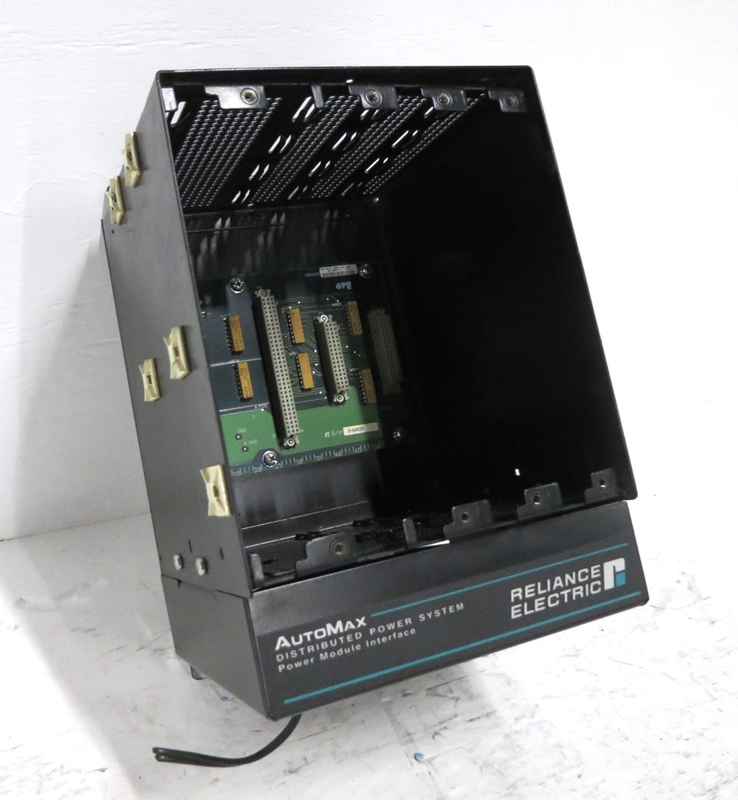Reliance 30FR7721 Control Unit
Brand:RELIANCE Model number:30FR7721
Country of origin: United States Product weight:0.55kg
HS code:9032899099
Product Details:
Product Dimensions:
A Reliance Control Unit primarily refers to their Programmable Logic Controllers (PLCs), such as the AutoMate series, and specialized drive control units designed for precise motor management. These units are robust, industrially hardened computers that differ from general-purpose computers in their design for harsh environments, real-time operating capabilities, and specialized programming interfaces.
Functionality:
PLCs (e.g., AutoMate 15/20/40 series): These units execute sequential control logic, handle timing and counting functions, perform arithmetic operations, and manage data. They receive inputs from sensors, process this information according to a user-defined program (often written in ladder logic, a graphical programming language), and then send outputs to control actuators. They are crucial for automating discrete manufacturing processes, packaging, and general machine control.
Drive Control Units (e.g., FlexPak, GV3000 series): These are highly specialized control units designed to manage the speed, torque, and position of electric motors. They integrate advanced control algorithms (like vector control) to optimize motor performance and energy efficiency. They communicate with the motor drive and often with a higher-level PLC or DCS.
Architecture: Many Reliance control units were modular, allowing users to select the appropriate CPU, power supply, and I/O modules to build a system tailored to their application. This modularity also facilitated maintenance and upgrades.
Key Features:
Real-time Operation: Designed for deterministic and fast execution of control programs, critical for industrial processes.
Robustness: Built to withstand industrial environments, including temperature fluctuations, vibration, dust, and electromagnetic interference.
Non-volatile Memory: Programs and configurations are typically stored in memory that retains data even during power loss, eliminating the need for battery backup in many cases.
Diagnostic Capabilities: Integrated diagnostic indicators (LEDs) and software tools for status monitoring and fault identification.
Communication Interfaces: Equipped with various ports (e.g., RS-232, RS-485) and network capabilities (e.g., R-NET industrial network) for communication with programming terminals, HMIs, SCADA systems, and other controllers.
Programming Flexibility: Supported common industrial programming languages, with ladder logic being prevalent.
Given the range of control units, parameters vary widely:
Processing Speed: Often measured in scan time (how long it takes to execute the entire program), or milliseconds per K-ladder element. Faster speeds are crucial for high-speed machinery.
Memory Capacity: Program memory (e.g., 1K, 2K, up to several MB for larger systems) and data memory (registers, data blocks).
I/O Capacity: The number of discrete (digital) and analog I/O points the unit can manage directly or indirectly via expansion modules.
Power Supply: Operating voltage requirements (e.g., 24V DC, 120/240V AC).
Communication Protocols: Supported protocols like R-NET, Modbus, proprietary serial protocols. Newer units (post-acquisition) would support Ethernet/IP, Profibus, etc.
Processor Type: The type of microprocessor used (e.g., custom ASIC, Intel-based) influencing performance.
Operating Temperature: Standard industrial ranges, typically -25°C to 70°C.
Physical Dimensions: Varies from compact, brick-style controllers to larger rack-mounted systems.
High Reliability: Reliance control units were engineered for exceptional reliability and continuous operation, a critical factor in industrial automation to minimize downtime.
Durability: Their rugged construction made them highly resistant to the harsh conditions found in manufacturing plants, including electrical noise, vibration, and temperature extremes.
Precise Control: Especially their drive control units excelled at delivering very accurate speed, torque, and position control for complex motion applications.
Ease of Use (for their time): With intuitive ladder logic programming and user-friendly interfaces (for the era), they simplified automation tasks for engineers and technicians.
Modular and Scalable: The modular design of PLC systems allowed users to build systems precisely to their needs and expand them as processes grew, offering excellent flexibility.
Integrated Diagnostics: Built-in diagnostic features and status indicators simplified troubleshooting, reducing maintenance time and costs.
Legacy Status: Many original Reliance Electric control units are now legacy products. While robust, new parts may be difficult to source, and technical support often relies on third-party specialists. Companies using these systems should consider migration strategies for long-term sustainability.
Programming Environment: Requires specific, often older, programming software and compatible hardware interfaces. Training for new personnel on these older systems can be a challenge.
Communication Compatibility: Ensure any new devices or modern IT systems can communicate with the older Reliance control units via supported protocols.
Cybersecurity: Older control units were not designed with modern cybersecurity threats in mind. Networked systems featuring these units require robust perimeter defenses and other compensating controls.
System Design Expertise: Maintaining and troubleshooting these systems often requires specialized knowledge of the specific Reliance platform.
Reliance control units were applied across a vast range of industries and applications:
Discrete Manufacturing:
Assembly line control, packaging machinery, pick-and-place systems.
Stamping presses, injection molding machines.
Process Industries:
Batch processing control in food and beverage, pharmaceuticals, and chemicals.
Flow, temperature, and pressure control in various continuous processes.
Material Handling:
Control of conveyors, robotic palletizers, automatic guided vehicles (AGVs).
Motion Control:
High-precision control of servo and AC/DC motors in industries like printing, textiles, and metal forming.
Heavy Industry:
Steel mills, paper mills, and mining operations for controlling large machinery and processes.
Utilities:
Control of pumps, valves, and monitoring systems in water and wastewater treatment plants.

We have the same series of models in stock. If you don't find the model you need, please contact us and we will provide you with an official quotation!
RELIANCE ELECTRIC 2GU41001
RELIANCE ELECTRIC 2KA845774-QF
RELIANCE ELECTRIC 2SR21200 D2-3291
RELIANCE ELECTRIC 2V2150
RELIANCE ELECTRIC 30FR4021
RELIANCE ELECTRIC 30FR4031
RELIANCE ELECTRIC 30FR4032
RELIANCE ELECTRIC 30FR7721
RELIANCE ELECTRIC 3MAF76181
RELIANCE ELECTRIC 3V4151
Colour:new Warranty: 12 months
Lead Time:3-day working day Price: Please contact us
Shipping Port: Xiamen, China Payment:T/T
Express cooperation: fedex, DHL, UPS and your express account
Service: Professional Sales provides 24 hours /7 days online service
Our service:

Fast delivery, and can be used with your express account.

Competitive Price

Free Shipping

One-year warranty